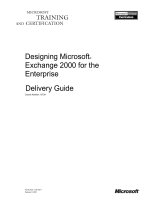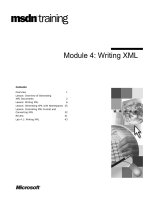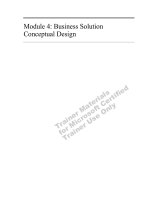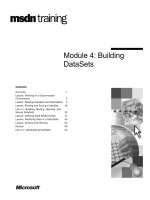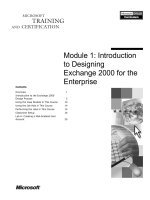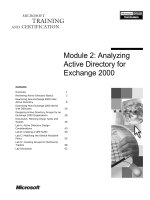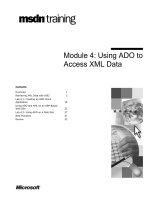Module 4: Exchange 2000 Architecture
Bạn đang xem bản rút gọn của tài liệu. Xem và tải ngay bản đầy đủ của tài liệu tại đây (1.94 MB, 36 trang )
&RQWHQWV##
2YHUYLHZ#4#
2YHUYLHZ#RI#WKH#([FKDQJH#5333##
$UFKLWHFWXUH#5#
([FKDQJH#5333#,QIRUPDWLRQ#6WRUH##
3URFHVV#7#
([FKDQJH#5333#,QWHUQHW#,QIRUPDWLRQ##
6HUYLFHV# 45#
([FKDQJH#5333#(YHQWV# 4<#
([FKDQJH#5333#0HVVDJH#)ORZ# 59#
5HYLHZ# 64#
#
Module 4:
Exchange 2000
Architecture
Information in this document is subject to change without notice. The names of companies,
products, people, characters, and/or data mentioned herein are fictitious and are in no way intended
to represent any real individual, company, product, or event, unless otherwise noted. Complying
with all applicable copyright laws is the responsibility of the user. No part of this document may
be reproduced or transmitted in any form or by any means, electronic or mechanical, for any
purpose, without the express written permission of Microsoft Corporation. If, however, your only
means of access is electronic, permission to print one copy is hereby granted.
Microsoft may have patents, patent applications, trademarks, copyrights, or other intellectual
property rights covering subject matter in this document. Except as expressly provided in any
written license agreement from Microsoft, the furnishing of this document does not give you any
license to these patents, trademarks, copyrights, or other intellectual property.
2000 Microsoft Corporation. All rights reserved.
Microsoft, MS-DOS, MS, Windows, Windows NT, Active Directory directory service, ActiveX,
BackOffice, FrontPage, Hotmail, MSN, Outlook, PowerPoint, SQL Server, Visual Studios, and
Win32, are either registered trademarks or trademarks of Microsoft Corporation in the U.S.A.
and/or other countries.
The names of companies, products, people, characters, and/or data mentioned herein are fictitious
and are in no way intended to represent any real individual, company, product, or event, unless
otherwise noted.
Other product and company names mentioned herein may be the trademarks of their respective
owners.
Project Lead:
David Phillips
Instructional Designers:
Lance Morrison (Wasser), Janet Sheperdigian, Steve Thues
Lead Program Manager:
Mark Adcock
Program Manager:
Lyle Curry, Scott Hay, Janice Howd, Steve Schwartz (Implement.Com),
Bill Wade (Wadeware LLC)
Graphic Artist:
Kimberly Jackson, Andrea Heuston (Artitudes Layout and Design)
Editing Manager:
Lynette Skinner
Editor:
Elizabeth Reese (Write Stuff)
Copy Editor:
Ed Casper (S&T Consulting), Carolyn Emory (S&T Consulting), Patricia Neff
(S&T Consulting), Noelle Robertson (S&T Consulting)
Online Program Manager:
Debbi Conger
Online Publications Manager:
Arlo Emerson (Aquent Partners)
Online Support:
Eric Brandt
Multimedia Developer
: Kelly Renner (Entex)
Compact Disc Testing:
Data Dimensions, Inc.
Production Support:
Ed Casper (S&T Consulting)
Manufacturing Manager:
Bo Galford
Manufacturing Support:
Rick Terek
Lead Product Manager, Development Services:
Lead Product Manager:
David Bramble
Group Product Manager:
Robert Stewart
# 0RGXOH#7=#([FKDQJH#5333#$UFKLWHFWXUH##LLL#
,QVWUXFWRU#1RWHV##
This module provides students with a high level overview of the component
architecture of Microsoft
®
Exchange 2000. They will learn that Exchange 2000
is designed to take advantage of Microsoft Windows
®
2000. This has led to a
number of fundamental architectural changes, including a more versatile
information store service, placement of protocol management in the Internet
Information Services, and event support for customizing mail-enabled software.
At the end of this module, students will be able to:
„#
Explain the architectural changes made from Microsoft Exchange Server 5.5
to Exchange 2000.
„#
Describe the benefits of the new information store architecture.
„#
Describe the advantages Exchange 2000 receives from Windows 2000
Active Directory
™
directory service.
„#
Describe the advantages Exchange 2000 receives from Internet information
services (IIS).
„#
Describe the new options developers receive from the event support in
Exchange 2000.
0DWHULDOV#DQG#3UHSDUDWLRQ#
This section provides you with the materials and preparation needed to teach
this module.
0DWHULDOV#
To teach this module, you need the following materials:
•
Microsoft PowerPoint
®
file 1569A_04.ppt
3UHSDUDWLRQ#
To prepare for this module, you should:
•
Read all the materials for this module.
3UHVHQWDWLRQ=##
78#0LQXWHV#
#
/DE=#
33#0LQXWHV#
LY##0RGXOH#7=#([FKDQJH#5333#$UFKLWHFWXUH#
0RGXOH#6WUDWHJ\#
Use the following strategy to present this module:
„#
Overview of the Exchange 2000 Architecture
Present a general overview of the architecture of Exchange 2000.
„#
Exchange 2000 Information Store Process
This section describes the new information store in Exchange 2000. Stress
that Exchange 2000 supports multiple stores and that each one is made up of
two databases, one for messages in Rich Text Format and one for messages
in their native format.
„#
Exchange 2000 Internet Information Services
Point out another major change from Exchange 5.5: IIS has been pulled into
the operating system and manages all client access protocols.
„#
Exchange 2000 Events
Describe the new capability to hook an Exchange event from a program and
then modify the message or event. If this section does not seem applicable
to the majority of your students, take a higher-level pass through it and let
interested students study it on their own. Events are not mentioned
elsewhere in the course.
„#
Exchange 2000 Message Flow
Use the diagrams in this section to trace the path of messages through
Exchange 2000.
# 0RGXOH#7=#([FKDQJH#5333#$UFKLWHFWXUH##4#
2YHUYLHZ#
„
2YHUYLHZ#RI#WKH#([FKDQJH#5333#$UFKLWHFWXUH
„
([FKDQJH#5333#,QIRUPDWLRQ#6WRUH#3URFHVV
„
([FKDQJH#5333#,QWHUQHW#,QIRUPDWLRQ#6HUYLFHV
„
([FKDQJH#5333#(YHQWV
„
([FKDQJH#5333#0HVVDJH#)ORZ
Microsoft
®
Exchange 2000 is designed to take full advantage of Microsoft
Windows
®
2000 as its foundation. Using Windows 2000 has led to a number of
fundamental changes; these include replacing the dedicated directory with
Windows 2000 Active Directory
™
, creating a more versatile information store,
placing protocol management in the Internet Information Services (IIS), and
adding event support for customizing mail-enabled software.
At the end of this module, you will be able to:
„#
Explain the architectural changes made from Microsoft Exchange Server 5.5
to Microsoft Exchange 2000.
„#
Describe the benefits of the new information store architecture.
„#
Describe the advantages Exchange 2000 receives from Microsoft
Windows 2000 Active Directory directory service.
„#
Describe the advantages Exchange 2000 receives from IIS.
„#
Describe the new options developers receive from the event support in
Exchange 2000.
6OLGH#2EMHFWLYH#
7R#SURYLGH#DQ#RYHUYLHZ#RI#
WKH#PRGXOH#WRSLFV#DQG#
REMHFWLYHV1#
/HDG0LQ#
,Q#WKLV#PRGXOH/#\RX#ZLOO#OHDUQ#
DERXW#WKH#IXQGDPHQWDO#
DUFKLWHFWXUDO#FKDQJHV#
EHWZHHQ#SUHYLRXV#YHUVLRQV#
RI#([FKDQJH#DQG#
([FKDQJH#53331#
5# # 0RGXOH#7=#([FKDQJH#5333#$UFKLWHFWXUH#
2YHUYLHZ#RI#WKH#([FKDQJH#5333#$UFKLWHFWXUH#
Store.exe
Information
Store
Information
Store
MAPI
Folder Replication XAPI
MTA
MTA
ESE
Logs
Logs
Database
Database
EXIPC
inetinfo.exe
SMTP
SMTP
POP3
POP3
IMAP
IMAP
NNTP
NNTP
HTTP-
DAV
HTTP-
DAV
IIS
IIS
Protocol Stubs
The major architectural changes introduced in Exchange 2000 involve
switching to Active Directory from the dedicated directory used in previous
versions of Exchange, extending the functions of the Extensible Storage Engine
(ESE) database, and moving protocol management to the Windows 2000 IIS
process.
([FKDQJH#5333#,QWHJUDWLRQ#ZLWK#$FWLYH#'LUHFWRU\#
Unlike previous versions of Exchange Server, Exchange 2000 no longer has a
dedicated directory. Instead, Exchange 2000 integrates with Windows 2000
Active Directory.
Exchange 2000 uses Active Directory to store all directory information. This
includes:
„#
Exchange 2000 configuration (stored in the Active Directory configuration
partition).
„#
Mailboxes.
„#
Server and site information.
„#
Mail recipients (stored in the Active Directory domain partition as Active
Directory objects).
„#
Custom recipients.
„#
Distribution lists (based on Active Directory groups).
6OLGH#2EMHFWLYH#
7R#LQWURGXFH#WKH#PDMRU#
VHFWLRQV#RI#WKH#
([FKDQJH#5333#
DUFKLWHFWXUH1#
/HDG0LQ#
([FKDQJH#5333¶V#
DUFKLWHFWXUH#KDV#FKDQJHG#
FRQVLGHUDEO\#IURP#SUHYLRXV#
YHUVLRQV#RI#([FKDQJH1#
# 0RGXOH#7=#([FKDQJH#5333#$UFKLWHFWXUH##6#
,QIRUPDWLRQ#6WRUH#3URFHVV#
The information store in Exchange 2000 is a service that stores data in an ESE
database. The Exchange 2000 information store includes new features that
make access to data easier and faster. The information store brings the Web, the
file system, and the collaboration server together into a single place for storing
information and deploying applications. It takes the best features of the
information store in previous versions of Exchange Server (transaction logging,
single-instance storage, rollback recovery, and online maintenance) and melds
them with Web technology to provide customers with more integrated
information management options.
Components of the information store include XAPI, which provides X.400
messaging services to previous version of Exchange Public Folder replication,
which manages the instances of public folders replicated to the local store.
MAPI support is also provided by the information store for Outlook and other
MAPI clients.
,QWHUQHW#,QIRUPDWLRQ#6HUYLFHV#
In Exchange 2000, the client access protocols are part of the IIS process, which
has become the protocol engine. Incorporating the protocols into the IIS process
enables system architects to host Exchange 2000 subsystems (protocol, storage,
and directory) on virtual servers on either the same computer or on different
computers. This makes Exchange 2000 more scalable than previous versions of
Exchange.
([FKDQJH#,QWHUSURFHVV#&RPPXQLFDWLRQV#/D\HU#
The Exchange Interprocess Communications Layer (EXIPC) provides a
queuing layer that enables the IIS and store processes (Inetinfo.exe and
Store.exe) to shuttle data back and forth very quickly. This is required to
achieve the best possible performance between the protocols and database
services on an Exchange 2000 server. Conventional applications require the
processor to switch contexts when transferring data between two processes.
7# # 0RGXOH#7=#([FKDQJH#5333#$UFKLWHFWXUH#
‹‹
#([FKDQJH#5333#,QIRUPDWLRQ#6WRUH#3URFHVV#
„
2YHUYLHZ#RI#WKH#,QIRUPDWLRQ#6WRUH
„
6XSSRUW#IRU#0XOWLSOH#'DWDEDVHV#LQ#([FKDQJH#5333
„
([FKDQJH#5333#1DWLYH#&RQWHQW#6WRUH
„
([FKDQJH#5333#,QVWDOODEOH#)LOH#6\VWHP
The information store can become the single place where you store and manage
documents, collaborate as a team, and run powerful business applications. The
information store combines the features and functionality of the file system, the
Web, and a collaboration server through a single location for storing, accessing,
and managing information, as well as building and running applications.
The information store integrates knowledge sources by providing a single
repository for managing e-mail messages, documents, Web pages, and other
resources within one infrastructure. The information store supports offline
access, remote client access, and support for a range of application
programming interfaces (APIs). In addition, the information store serves as a
platform for unified messaging, where knowledge workers can access personal
information, such as their calendars and contacts, as well as e-mail and voice
mail messages.
6OLGH#2EMHFWLYH#
7R#LQWURGXFH#DQG#GHVFULEH#
WKH#FDSDELOLWLHV#RI#WKH#
([FKDQJH#5333#LQIRUPDWLRQ#
VWRUH1#
/HDG0LQ#
7KH#LQIRUPDWLRQ#VWRUH#
FRPELQHV#WKH#IHDWXUHV#DQG#
IXQFWLRQDOLW\#RI#WKH#ILOH#
V\VWHP/#WKH#:HE/#DQG#D#
FROODERUDWLRQ#VHUYHU1#
# 0RGXOH#7=#([FKDQJH#5333#$UFKLWHFWXUH##8#
2YHUYLHZ#RI#WKH#,QIRUPDWLRQ#6WRUH##
Store.exe
ESE
Logs
Logs
Database
Database
Information
Store
Information
Store
MAPI
Folder Replication XAPI
MTA
MTA
(;,3&
LQHWLQIR1H[H
6073 3236 ,0$3 1173
+7730
'$9
,,6
3URWRFRO#6WXEV
You can configure Exchange 2000 to create multiple information stores on a
single Exchange 2000 server. Each information store is made up of two
databases, one for storing Rich Text Format (RTF) messages and another for
storing messages in their native form.
%HQHILWV#RI#WKH#1HZ#,QIRUPDWLRQ#6WRUH#$UFKLWHFWXUH#
Support for multiple information stores provides Exchange 2000 with the best
of two worlds: the ability to create very large databases for large-scale
enterprises and the option of splitting a single logical database into separate
physical databases to increase overall system reliability, enable much faster
backup, and speed up the recovery process in the event of hardware failure. For
example, if the hardware running a part of the overall e-mail database fails, only
that database is affected during repair, while the others continue to serve their
e-mail users, even though the database is administered as a single unit.
By storing messages in their native formats, Exchange 2000 server avoids the
overhead required to convert each arriving message into RTF, as it had to do in
earlier versions. Storing messages in their native formats enables
Exchange 2000 to support non-MAPI clients effectively without sacrificing
performance.
6OLGH#2EMHFWLYH#
7R#H[SODLQ#WKDW#WKH#
LQIRUPDWLRQ#VWRUH#LV#
FRPSRVHG#RI#WZR#
GDWDEDVHV1#
/HDG0LQ#
$Q#LQIRUPDWLRQ#VWRUH#LV#
PDGH#XS#RI#WZR#GDWDEDVHV/#
RQH#IRU#VWRULQJ#5LFK#7H[W#
)RUPDW#PHVVDJHV#DQG#
DQRWKHU#IRU#VWRULQJ#
PHVVDJHV#LQ#WKHLU#QDWLYH#
IRUP1#
9# # 0RGXOH#7=#([FKDQJH#5333#$UFKLWHFWXUH#
)HDWXUHV#RI#WKH#,QIRUPDWLRQ#6WRUH#
The information store includes:
„#
A database managed as a hierarchical file system of folders and items.
„#
Support for various types of native Web content.
„#
Accessibility to all information by using common URLs.
„#
Consistent access to the information store through Outlook, other e-mail
clients, Windows Explorer, and any Internet browser.
„#
Built-in content indexing and search.
„#
Several protocols and APIs for remote client access.
# 0RGXOH#7=#([FKDQJH#5333#$UFKLWHFWXUH##:#
6XSSRUW#IRU#0XOWLSOH#'DWDEDVHV#LQ#([FKDQJH#5333#
„
6WRUH#&DQ#'\QDPLFDOO\#0RXQW#0XOWLSOH#3K\VLFDO#
'DWDEDVHV
ESE
ESE
Transaction Log
Transaction Log
Store
Store
Store
Store
Store
Store
Store
Store
Store
Store
Store
Store
Storage Group A Storage Group B
Transaction Log
Transaction Log
Store
Store
Store
Store
Store
Store
Store
Store
Store
Store
Store
Store
ESE
ESE
In previous versions of Exchange, the number of users a server could host was
limited by the time required to back up and restore large databases. When an
Exchange server database became too large to back up or restore in a reasonable
amount of time, another Exchange server was required to share the load.
Database size became the bottleneck in the number of users an Exchange server
could manage.
6XSSRUW#IRU#0XOWLSOH#'DWDEDVHV#
Exchange 2000 overcomes the database size limitations of previous Exchange
versions by introducing support for multiple databases and storage groups on
the same server. Although each instance of a database runs under the same
information store process (there can be only one information store process
running per server), you can mount or dismount individual databases
dynamically. This means you can restore an individual database from backup
while other database instances service client requests.
0XOWLSOH#GDWDEDVHV#RQ#D#VLQJOH#GLVN#
Creating multiple Exchange 2000 databases on a single disk does not protect
against catastrophic failure. If you have five 10GB databases on a single disk
and the disk fails, all five databases will have to be restored. However, if one of
the five databases becomes corrupt, that single database can be restored while
the other databases remain online.
0XOWLSOH#GDWDEDVHV#RQ#D#GLVN#DUUD\#
One of the most common fault tolerant solutions is redundant array of
independent disks (RAID) 5. By creating multiple databases on a hardware
RAID partition, a disk can be replaced while the databases remain online, and a
database can be restored while the other databases remain online.
The goal of having multiple databases is to allow companies to increase the number of simultaneous users that can be maintained on a
Exchange 2000 is not designed to hold a single mailbox per database.
This type of deployment would be costly and resource-intensive to maintain.
6OLGH#2EMHFWLYH#
7R#H[SODLQ#KRZ#WKH#XVH#RI#
PXOWLSOH#GDWDEDVHV#PDNHV#
([FKDQJH#5333#PRUH#
VFDODEOH1#
/HDG0LQ#
([FKDQJH#5333#RYHUFRPHV#
WKH#GDWDEDVH#VL]H#OLPLWDWLRQV#
RI#SUHYLRXV#([FKDQJH#
YHUVLRQV#E\#LQWURGXFLQJ#
VXSSRUW#IRU#PXOWLSOH#
GDWDEDVHV#DQG#VWRUDJH#
JURXSV#RQ#WKH#VDPH#
FRPSXWHU1#
1RWH#
;# # 0RGXOH#7=#([FKDQJH#5333#$UFKLWHFWXUH#
6WRUDJH#*URXSV#
Exchange 2000 information stores are organized in storage groups. A storage
group is a set of databases that share the same set of transaction log files and
can be managed either as a group or independently by the administrator. An
administrator can create up to 15 storage groups per Exchange 2000 server.
Each storage group can host up to six information stores.
There can actually be up to 16 storage groups per Exchange 2000 server.
However, one storage group is reserved for system use.
'HSOR\PHQW#6FHQDULRV#IRU#0XOWLSOH#'DWDEDVHV#
You need to consider many performance and resource implications when
deciding how to configure multiple databases on a computer running
Exchange 2000. Before you decide on the disk layout for your server, consider
the reasons and benefits for configuring more than one database.
0XOWLSOH#&RPSDQ\#6FHQDULR#
When you need to host multiple companies on the same computer running
Exchange 2000, you can use a different collection of databases for each one.
You can then configure each database with different policies, such as storage
and retention limits. In addition, you can back up and restore each database
independently.
6XSSRUW#IRU#9,3#0DLOER[#6FHQDULR#
Although the information store is not designed for a single mailbox per
database, you can host a limited number of smaller databases without incurring
heavy resource costs. This enables those users who require short restore times
to be grouped together in a limited user database designed to be quickly
restorable.
6HUYLFH#/HYHO#$JUHHPHQW#6FHQDULR#
It is common for medium and large companies to have service level agreements
(SLA), which define reasonable downtime. The SLA usually commits a
company to have services restored within a certain amount of time. Of course,
this varies from company to company and depends on how critical a company
views messaging information.
You need to consider what database configuration scenario will yield the
highest availability for users in your company and at what cost. Calculating the
maximum time it would take to perform a disaster recovery with your hardware
and software will help to determine the conditions of the SLA.
It is important to define what corporate data is stored in Exchange 2000.
Through the Exchange Installable File System, it is possible to host file shares
on Exchange 2000. You will need to define under what SLA these shares fall.
1RWH#
1RWH#
# 0RGXOH#7=#([FKDQJH#5333#$UFKLWHFWXUH##<#
([FKDQJH#5333#1DWLYH#&RQWHQW#6WRUH#
Mailbox Store
EDB
EDB
STM
STM
LOG
LOG
LOG
Heade
r
Heade
r
Header & Body
Header & Body
Internet Message
Stream
Previous versions of Exchange only stored messages in message database
encapsulated format (MDBEF). This is the native format for Outlook clients.
When a non-MAPI client requested a message, the information store had to
convert the contents from MDBEF to the appropriate format based on what the
client requested. This conversion consumed processor bandwidth and slowed
server performance. To reduce this overhead, the information store in
Exchange 2000 is split into the following two types of storage files:
„#
Native content store (.stm file). When Exchange 2000 receives a message
from a client other than Outlook (MAPI), Exchange stores the message in its
native format, either Multipurpose Internet Mail Extensions (MIME) or
non-MIME format, in the native content storage file. If an Outlook client
tries to read data from the native content store, Exchange 2000 converts the
data from MIME content into MAPI content and passes it back to the
Outlook client.
„#
Rich-text store (.edb file). Messages from MAPI clients such as Outlook are
stored in the rich-text store, as they were in previous versions of Exchange
Server. MAPI clients can then access these messages without conversion.
However, if an Internet protocol-based client attempts to read a rich-text
message, then the message is converted to the requested format.
6OLGH#2EMHFWLYH#
7R#H[SODLQ#KRZ#WKH#DELOLW\#WR#
VWRUH#PHVVDJHV#LQ#WKHLU#
QDWLYH#IRUP#PDNHV#PHVVDJH#
WUDQVIHUV#PRUH#HIILFLHQW#WKDW#
LQ#SUHYLRXV#([FKDQJH#
YHUVLRQV1#
/HDG0LQ#
,Q#SUHYLRXV#YHUVLRQV#RI#
([FKDQJH/#DOO#PHVVDJHV#
ZHUH#VWRUHG#LQ#2XWORRN¶V#
QDWLYH#PHVVDJH#IRUPDW>#WKLV#
PHDQW#WKH\#KDG#WR#EH#
FRQYHUWHG#WR#WKH#DSSURSULDWH#
IRUPDW#WR#EH#SDVVHG#WR#QRQ0
0$3,#FOLHQWV1#
43# # 0RGXOH#7=#([FKDQJH#5333#$UFKLWHFWXUH#
2Q0'HPDQG#&RQWHQW#&RQYHUVLRQ#LQ#([FKDQJH#5333#
Exchange 2000 does not perform content conversion until a client requests a
message from the native store that is in a format it cannot read—this is known
as on-demand content conversion. For example, when a client receives a
message through an Internet protocol, Exchange 2000 sends the data to the
native content store. When another Internet protocol-based client attempts to
read the data, it streams directly out of the native content store without ever
being converted.
On-demand content conversion occurs when a client tries to read a message
from a data store not native to the client. For example, when an Outlook client
reads a message that is stored in the native content store, the message is
converted and passed to the Outlook client. The message is not moved from the
native content store to the rich-text store, and the conversion is done very
quickly in memory.
The message will be copied between stores if a client that is reading the
message makes a change. For example, if an Outlook client opens a message
that is stored in the native content store, makes a change, and then saves the
message, the saved message will be written to the rich-text store instead of back
to the native store.
1DWLYH#&RQWHQW#6WRUDJH#'DWDEDVH#)RUPDW#
The native content store is an ESE database. Just like the rich-text store, it uses
4 KB pages and is capable of allocating data between non-contiguous areas.
Additionally, like the rich-text store, the native content store defragments and
compacts the data it contains.
6L]H#RI#WKH#'DWDEDVH#
The information store size is a combination of both the rich-text store and the
native content store size, along with the associated transaction logs. Backup
products use the backup API to call the data out of the database so you will not
see two separate files.
During a database restoration, both storage files must be restored, as there are
some properties that are shared between the two databases.

